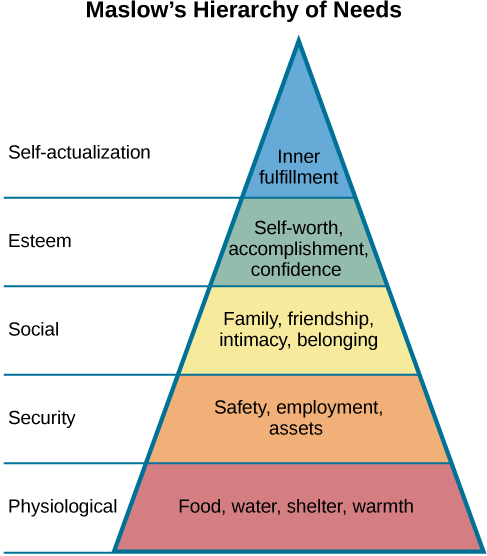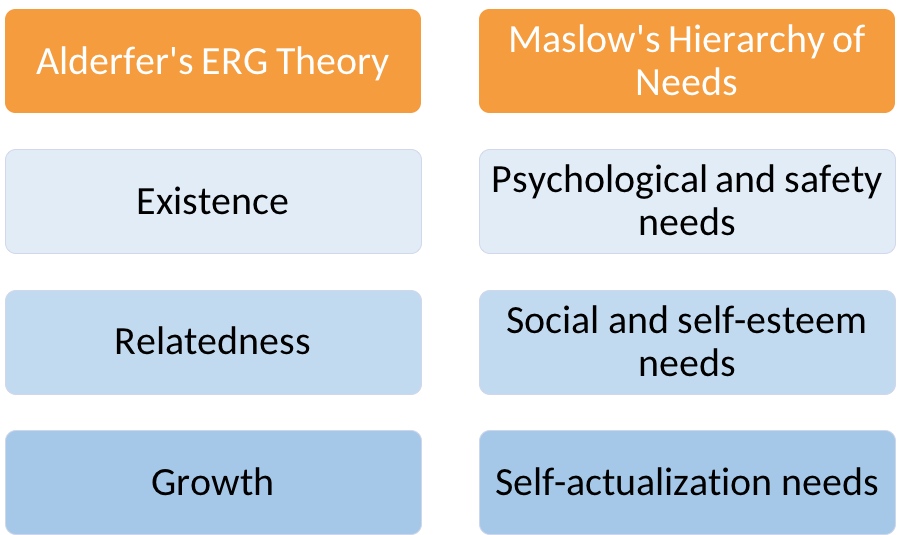11.16: Needs-Based Theories of Motivation
- Page ID
- 47754
- Differentiate between Maslow’s hierarchy of needs and Herzberger’s two-factor theory of needs.
- Explain Alderfer’s existence-relatedness-growth theory.
- Explain McClelland’s acquired-needs theory.
Maslow’s Hierarchy of Needs
Abraham Maslow, one of the most prominent psychologists of the twentieth century, created a hierarchy of needs, illustrated by a pyramid representing how human needs are ranked. Maslow’s theory is based on the premise that human beings are motivated by needs ranked in order hierarchically. Some of these needs are simply essential to all human beings. When a basic need is satisfied, we begin to seek higher-order needs.

The first essential motivational needs, according to Maslow, are our physiological needs, such as air, food, and water. Once our physiological needs are satisfied, we become concerned about safety, which includes our own physical safety and security, as well as our employment security. The next need to fill is social: our need to bond with other human beings. The need for love, friendship, and family is considered to be a fundamental human motivation. When we have achieved a sense of belonging, our need for esteem—the desire to be respected by one’s peers, feel important, and be appreciated—becomes more salient. The highest level of the hierarchy is the need for self-actualization, which refers to “becoming all you are capable of becoming.”[1] People can fulfill this need by learning new skills, taking on new challenges, and taking action to pursue their life goals.[2]
Two-Factor Theory
When studying motivation, Frederick Herzberg started by asking employees what was satisfying and dissatisfying on the job. Herzberg found that certain factors just had to be met and did not raise satisfaction. However, if these factors, called hygiene factors, were not met, it led to strong dissatisfaction. The hygiene factors causing dissatisfaction were part of the context in which the job was performed. Company policies, supervision, working conditions, salary, safety, and security on the job are some examples of hygiene factors. For example, you may not link your satisfaction to your office having good lighting, but you would be very dissatisfied if the lighting was too poor to read.
Motivators are the factors that employees need in order to give higher levels of effort. According to Herzberg, the strongest motivators are interesting work, responsibility, achievement, recognition, growth, and advancement.
ERG Theory
Clayton Alderfer modified Maslow’s hierarchy of needs into three categories: existence, relatedness, and growth (ERG). The figure below illustrates how the ERG needs correspond to Maslow’s five levels. Existence corresponds to psychological and safety needs; relatedness corresponds to social and self-esteem needs; and growth corresponds to self-actualization needs. The ERG theory does not force the order of needs fulfillment, and it supports the pursuit of different levels simultaneously. As a manager, you may notice some people regressing, which shows up when they continue to put effort into lower-level needs rather than pursuing the higher-level needs. The theory suggests that managers will need to help regressing employees see the importance of their pursuit of higher needs to their personal growth. This is referred to as the frustration-regression principle.

Acquired Needs Theory
Some studies have found that David McClelland’s acquired needs theory can predict success in management. The need for achievement, affiliation, and power all operate in combination and are the result of a person’s life experiences.
People who have a strong need to be successful have a high need for achievement. A high need for achievement results in a high level of satisfaction when that person completes projects on time, closes sales with prospects, or drives new and innovative ideas. Jobs that have very explicit goals to be reached are ideal for individuals who have a high need for achievement. Feedback must be regularly available and easy to understand, as they need feedback to determine their next steps in pursuit of the goal. However, a high need for achievement can be problematic as a person is promoted into management. Instead of relentlessly pursuing his or her own goals, this manager must now get the work done by motivating others. It is not uncommon for a manager with a high need for achievement to view coaching and meeting with subordinates as unnecessary. This type of manager will need to resist micromanaging or trying to do the work himself.
People with a high need for affiliation value building relationships. The affiliation-driven employee will be effective in team settings, a strong collaborator, and eager to work with new people.
Managers with a high need for affiliation may find it difficult to deliver unpleasant news and critical feedback. The affiliation-driven manager will need to see the value of providing feedback that will help poor-performing subordinates improve.
People with a high need for power are motivated to influence others and control their environment. Their focus is on the larger strategy, the “big picture.” The need for power can be positive in improving the way work is done, negotiating for more resources for a department, or gaining more responsibility for a team. The need for power can be a negative for the firm when it means beating someone else. Of the three acquired needs, the need for power is strongly correlated with effectiveness in managerial and leadership positions.[3]
As a manager, you will be wise to understand employees’ different needs and how that will translate into motivation. Clearly defined goals, timelines, and feedback will be attractive to those with a high need for achievement. Providing and encouraging acknowledgment of good work will motivate people with a high need for affiliation. Employees with a high need for power will be looking for opportunities with more influence and decision making.
- Abraham H. Maslow, “A Theory of Human Motivation,” Psychological Review 50 (1943): 370–396 ↵
- Abraham H. Maslow, Motivation and personality, New York: Harper, 1954 ↵
- David C. McClelland and Richard E. Boyatzis, “Leadership Motive Pattern and Long-Term Success in Management,” Journal of Applied Psychology 67 (1982): 737–743 ↵
Contributors and Attributions
- Needs-Based Theories of Motivation. Authored by: David J. Thompson and Lumen Learning. License: CC BY: Attribution
- Image: Alderfer's ERG Theory. Authored by: Lumen Learning. License: CC BY: Attribution
- Image: Maslow's Hierarchy of Needs. Provided by: OpenStax CNX. Located at: http://cnx.org/contents/Sr8Ev5Og@5.52:MLADqXMi@5/Motivation. License: CC BY: Attribution. License Terms: Download for free at http://cnx.org/contents/4abf04bf-93a...fd46e68cc@5.48


